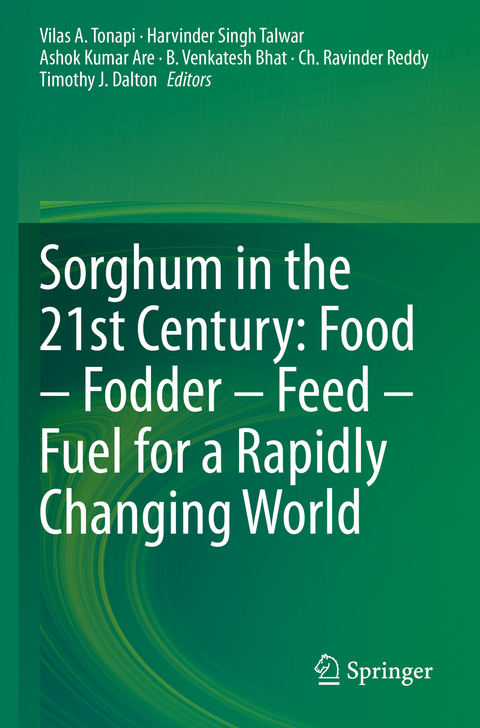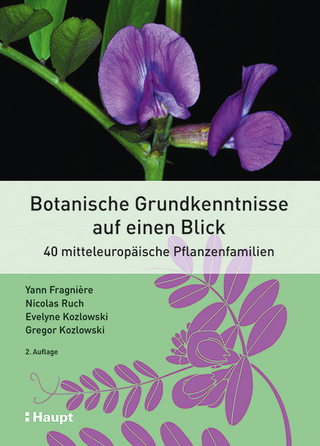
Sorghum in the 21st Century: Food – Fodder – Feed – Fuel for a Rapidly Changing World
Springer Verlag, Singapore
978-981-15-8251-6 (ISBN)
Dr. Vilas A. Tonapi is Director of ICAR- Indian Institute of Millets Research, Hyderabad, India. He is with the sorghum and Millets programme since 1990. He has also served as Head, Division of Seed Science and Technology, Indian Agricultural Research Institute, New Delhi. He had his graduation and post-graduation from UAS, Bangalaore (Dharwad campus) and Ph.D from TNAU, Coimbatore. He did his post-Doctoral from University of Queensland, Australia. His special attainments include Planning, development and management of crop improvement programs and strategies for food and nutritional security of self and cross-pollinated crops for dry and irrigated ecosystems, Participatory seed system development, Developmental initiatives in seed Technology, seed quality assurance, new seed policy and development of sustainable food and Community seed systems, Seed industry development, Protection of Plant varieties, IPR management, DUS Testing, and Research on physiological, biochemical and molecular basis of seed vigour/longevity. He has been awarded RV Swaminathan He has been the consultant to FAO on seed system development. He was part of USDA Global ergot collection and characterization mission. He has been awarded the distinguished service award to seed industry by Seedsmen Association. He has to his credit 52 research papers in peer reviewed journals, 30 authored and edited books, and more than 75 papers presented in various seminars and symposia. Dr Harvinder S. Talwar has more than 39 years of research experience in area of stress physiology of legumes, sorghum and small millets. He started his career as researcher in 1981 at International Crops Research Institute for Semi-arid tropics (ICRISAT), Hyderabad. During his association with ICRISAT, his major accomplishments includes developing of cold tolerant chickpea lines and a screening technique for heat tolerance in groundnut. Dr Talwar joined Indian Council of Agricultural Research (ICAR) during 2000 and worked on arid legumes in central arid zone Research Institute (CAZRI) Jodhpur. His major accomplishment includes the identification of sources of clusterbean and moth beans with improved drought tolerance. He is with Indian institute of millets research since 2006 and is working on drought tolerance in sorghum and Finger millet. He has deciphered the principal components of postflowering drought and the mechanism with which staygreen trait improves resilience to Rabi Sorghum in moisture receding environment. He has to his credit 86 publications of various categories which include 72 pear reviewed research papers in national and international journals and co-edited 3 books. Ashok Kumar Are is Principal Scientist and Product Placement Lead -Asia at International Crops Research Institute for the Semiarid Tropics (ICRISAT), India (www.icrisat.org). He has 20 years of research experience in the area of genetics, plant breeding and provided vision and operational plans for improvedproducts development in various crops. Since 2006, his major focus is on modernizing the breeding programs to enhance breeding efficiency for higher genetic gain and development of demand-led improved products in sorghum for various end-uses- food, feed, fodder and fuel. Besides improving sorghum for food and forage, he led the projects on genetic diversification of hybrid parents for rainy and postrainy season ^40 international partnerships in various projects and provided international consultancies to FAO and IAEA. He is currently guiding two Ph D students. B. Venkatesh Bhat is Principal scientist (Genetics & Cytogenetics) at ICAR- Indian Institute of Millets Research, Hyderabad. Dr Bhat started his career as a scientist at the Indian Grassland and Fodder Research Institute, Jhansi where he conducted research on genetic improvement of forage sorghum, range grasses and forage legumes for a decade and subsequently moved to ICAR- Indian Institute of Millets Research, Hyderabad. He has two years’ post-doctoral research experience on biotechnological approaches for sorghum improvement at ICRISAT, Patancheru, He has 25 years of research experience in genetic improvement of sorghum, millets and fodder crops. His areas of research experience are forage sorghum improvement for yield and quality, sweet sorghum feed stock development, research on apomixis for fixing hybrid vigour in crops, tissue culture, genetic transformation and molecular breeding in sorghum. He has co-authored over 30 peer-reviewed research articles, 16 book chapters and co-edited five books. Dr. Reddy obtained his graduation and post-graduation certificate in the discipline of Plant Pathology from Tamil Nadu Agricultural University, India. Worked as Plant Pathologist at ICRISAT, subsequently worked as Senior Scientist (Technology Exchange) shifted his focus on to agriculture development projects entrusted with project development, implementation, monitoring and evaluation of the projects on enhancing production of food, fodder and fuel in South East Asian countries. After retirement in 2015 form ICRISAT worked as Director, at MS Swaminathan Research Foundation and presently working as Director (quality control) at Patanjali Bio Research Institute, Haridwar, India. Dr. Reddy has published more than 25 research articles and 12 books and bulletins. Timothy J. Dalton is a Professor of International Agricultural Development in the Department of Agricultural Economics at Kansas State University in Manhattan, Kansas USA. With over 25 years of experience in ex-post and ex-ante assessment of new agricultural technologies in Africa, Asia and the United States, he studies how new varieties of sorghum, rice, and maize affect food productivity, production risk management, and nutrition, as well as the impact of natural resource degradation—primarily soils and agricultural biodiversity—on agriculture and human well-being. He received a B.A.for Columbia University, M.S. from the University of Illinois and a Ph.D. from Purdue University. He is the author or co-author on over 50 peer-reviewed publications and has received more than US$37 million in competitive research funding from state, Federal, industry and foundation sources.
Chapter 1.Trends in Global Production, Consumption and Utilization of Sorghum.- Chapter 2. Enabling Markets, Trade and Policies for Enhancing Sorghum Uptake.- Chapter 3. Global Status of Sorghum Genetic Resources Conservation.- Chapter 4. Wide Hybridization and Utilization of Wild Relatives of Sorghum.- Chapter 5. Sorghum Germplasm for Enhanced Productivity and Nutrition.- Chapter 6. Physiology of Growth, Development and Yield.- Chapter 7. Impacts of Abiotic Stresses on Sorghum Physiology.- Chapter 8. Sorghum; General Crop Modelling Tools Guiding Principles and Use of Crop Models in Support of Crop Improvement Programs in Developing Countries.- Chapter 9. Biological Nitrifications Inhibition (BNI) Potential and its Role in Improving the Nitrogen Use Efficiency in Sorghum . Chapter 10. High Throughput Phenotyping Methods for Economic Traits and Designer Plant Types, as Tools to Support Modern Breeding Efforts.- Chapter 11. Sorghum Management Systems and Production Technology around theGlobe.- Chapter 12. Sorghum Hybrid Seed Production and Quality Management: Important Considerations.- Chapter 13. Tackling Key Issues for Smallholder Farmers: The Farmer Research Network (FRN)Approach.- Chapter 14. Commercial Sector Breeding of Sorghum Current Status and Future Prospects.- Chapter 15. Breeding for Yield and Adaptation.- Chapter 16. Breeding for Biotic Stresses Resistance.- Chapter 17. Breeding for Forage and Feed- Status and Approaches.- Chapter 18. Genetic and Management Options for Controlling Striga.- Chapter 19. Breeding Sorghum for Specific End Uses.- Chapter 20. The Sorghum Genome Current Status and Future Opportunities .- Chapter 21. Current Status and Future Prospects of Genetic Transformation and Gene Editing in Sorghum. Chapter 22. Major Pests: Status, Approaches and Strategies for Management.- Chapter 23. Sorghum Diseases: Diagnosis and Management.- Chapter 24. Harmonization of Quarantine Regulation and Legislation for Global Exchange of Sorghum Germplasm.-Chapter 25. Weed Management in Sorghum.- Chapter 26. Options for Enhancing Sorghum Forage Utilization in Ruminants.- Chapter 27. Multi-Trait Improvement in Sorghum to Optimize Livelihoods from Mixed Crop Livestock Systems and the Impact of Augmented New Cultivar Release Criteria.- Chapter 28. Sweet Sorghum as First Generation Biofuel Feedstock and its Commercialization.- Chapter 29. High-Biomass Sorghums as a Feedstock for Renewable Fuels and Chemicals.- Chapter 30. Pre-Treatment Methods for Biofuel Production from Sorghum.- Chapter 31. Genetic Enhancement Perspectives and Prospects for Grain Nutrients Density.- Chapter 32. Approaches for Enhancing the Nutrients Bioavailability. Chapter 33. Functional Characteristics and Neutraceuticals of Grain Sorghum.- Chapter 34. Novel Processes, Value Chain and Products for Food, Feed and Industrial Uses.- Chapter 35. Developing Sustainable Seed System for Higher Productivity.- Chapter 36. Sorghum in 21st century- Perspectives and Prospects.
| Erscheinungsdatum | 17.01.2022 |
|---|---|
| Zusatzinfo | 137 Illustrations, black and white; XXVI, 940 p. 137 illus. |
| Verlagsort | Singapore |
| Sprache | englisch |
| Maße | 155 x 235 mm |
| Themenwelt | Naturwissenschaften ► Biologie ► Botanik |
| Naturwissenschaften ► Biologie ► Ökologie / Naturschutz | |
| Weitere Fachgebiete ► Land- / Forstwirtschaft / Fischerei | |
| Schlagworte | Crop improvement • crop production • Food-fodder-feed-fuel • Genetic resources conservation • natural resources and energy economics • sorghum |
| ISBN-10 | 981-15-8251-3 / 9811582513 |
| ISBN-13 | 978-981-15-8251-6 / 9789811582516 |
| Zustand | Neuware |
| Informationen gemäß Produktsicherheitsverordnung (GPSR) | |
| Haben Sie eine Frage zum Produkt? |
aus dem Bereich


